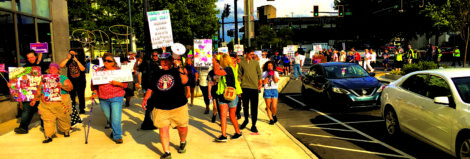Drug, gun arrests rise; violence falls in Youngstown

Youngstown police Chief Carl Davis, in his office, shows the feed from a fixed surveillance camera being used in Youngstown to monitor activities at one of the “hot spot” areas where crimes frequently occur. The city has 11 such cameras and will install at least four more in the coming months.... Staff photo / Ed Runyan
YOUNGSTOWN — Youngstown during 2021 was facing the twin pandemics of violence and COVID-19.
The city’s police department and mayor scrambled to pick up the pieces resulting from an escalating six-month period of violence culminating in 10-year-old Persayus Davis-May being shot to death in her home by bullets apparently intended for adults.
Mayor Jamael Tito Brown and police Chief Carl Davis announced several initiatives throughout the year to bring more law-enforcement resources into the city. Much of that effort aimed to remove guns and drugs.
Two years later, crime statistics suggest that the efforts have worked, with the number of violent crimes dropping from 179 during the second half of 2021 to 109 during the first half of this year.
Homicides are among the crime categories with improved numbers. The city has had eight homicides so far this year. There were 23 homicides in all of 2022.
Davis said the statistics back up what he believes: “I would say the initiatives we have in place are working for us. At one time, I would say they appear to be working, but now it’s absolutely clear they are working. The (violent crime) numbers are trending downward.”
Davis said the statistics provided to The Vindicator by the police department’s crime analyst, Julie Orto, also confirm what the newspaper has observed in the past couple of years: The number of drug charges being indicted has risen significantly.
During the second half of 2021, Youngstown police filed charges 86 times for drug offenses. But the number has steadily risen to 188 during the first half of this year.
“Drugs often are the driver of violent crime, so if we are addressing that or attacking that, you’re going to see the violent crime numbers go down,” Davis said.
“Now the offenders know we’re out here addressing this,” he said of drug offenses, such as trafficking. “We’ve really honed in on drug offenses, and we’re seeing the results now.”
Mike Yacovone, Mahoning County assistant prosecutor who handles presentment to the county grand jury of most felony criminal cases, said he agrees that the Youngstown Police Department has increased the number of drug-related cases it has brought to him in the last couple of years.
He attributes the increase to the work of the Youngstown Police Department — especially its Neighborhood Response Unit. And he cites not just the additional work to reduce drug dealing, but the work to take guns off the streets.
“The NRU unit is out, and they are looking for guns,” Yacovone said. “The age-old adage is that guns and drugs go hand-in hand, so with more guns are more drugs.”
GUN SPECIFICATIONS
Yacovone added that the prosecutor’s office joined the effort to reduce drug and weapons violations a couple of years ago by adding gun specifications to felony drug crimes where applicable.
“We’ve started adding firearms specifications onto drug charges, if you have a gun on you,” he said. “I think maybe now (drug and gun offenders) know, ‘I shouldn’t have a gun on me if I am going to have my drugs on me,'” he said.
Yacovone said the prosecutor’s office previously focused on putting gun specifications on higher-level violent crimes, but when Youngstown’s violence grew in 2021, it appeared necessary to extend the filing of gun specifications to lower-level drug offenses, he said.
“We had such an uptick in guns and violent crimes in about 2021, when we started getting all of those murders; we wanted to do something to deter carrying a gun,” he said.
Before using gun specifications in this way, a person might be convicted of a low-level felony drug charge “and get probation and that’s it. But now, I put a one-year gun specification on it, meaning you had a gun under your control while possessing that cocaine; by law, no matter what, you have to do the one year” in prison, Yacovone said.
Capt. Jason Simon, head of the police department’s detective division, agreed that the Neighborhood Response Unit that Davis created “is one component in this violent crime reduction success.”
He said the NRU’s focus on “street-level” drugs and guns has “a direct (and immediate) effect on violent crime because it is the street-level individuals who are committing most of the neighborhood- level violent crime.”
He added, “Most of our homicides are either drug-related, or what we’ve been seeing lately is people not having the ability to successfully resolve conflicts.”
2021 VIOLENCE
When a 13-year-old girl was shot in the leg while in her bed on East Avondale Avenue on the South Side at 2 a.m. March 31, 2021, it sounded alarms of concern in the community, especially among staff and students at nearby Taft Elementary School. The girl survived.
Later, two teens and an adult were convicted of the shooting, including the shooter, 16, who fired at the home to “even a score” over earlier conflicts.
The Avondale shooting was around the time that America was recovering from the worst of the COVID-19 pandemic, and people were starting to come out of their homes.
Seven weeks later, early May 23, Youngstown police found a “chaotic scene” on Salt Springs Road on the West Side at the Torch Club bar, where two people were shot to death in a confrontation with guns.
But the incident that caused the most grief and frustration happened Aug. 18, when 10-year-old Persayus Davis-May was shot and killed in her home on Samuel Avenue on the South Side, apparently from bullets intended for adults who were outside of the home. Three adults were injured.
“This is a dark day for our community, probably the darkest I’ve ever had as mayor,” Mayor Jamael Tito Brown said at a news conference, tears running down his face.
For the girl’s funeral, her body was carried down Glenwood Avenue on a horse-drawn wagon in in a rounded glass-top casket — so that people could see her in her princess outfit and tiara.
Throughout that violent period, Davis, Brown and others announced initiatives aimed at reducing violence.
At the end of April, Davis and Brown announced the formation of the police department’s Neighborhood Response Unit, whose mission is to focus on neighborhoods — mostly on the South Side.
“Their main objective is to reduce violent crimes by removing these dangerous criminals from the street,” Davis said. Five patrol officers were assigned to the unit, which is led by Lt. Gerald Slattery.
At about the same time, the city announced the return of Operation Steel Penguin, which focused on people possessing firearms who are not allowed. Their crimes would be referred to the U.S. Attorney’s Office for federal prosecution.
A couple of months later, the police department also restarted its community policing unit, which involves one officer being assigned to each city ward to address crime and quality-of-life issues.
Early that September, officials announced the Impact Initiative that involved the Ohio State Highway Patrol and other agencies coming into the city to provide additional assistance to city police.
Simon noted at the time that the extra steps were needed because the country was facing a “second pandemic” — “an increase in violent crime — of homicides and a proliferation of firearms in the hands of those who have no business possessing them.”
The police department has other programs aimed at lessening violence, including its Community Initiative to Reduce Violence. The community also has stepped up to hold marches. Also, new programs help residents returning to the community after being incarcerated, Simon stated.
“We are convinced it is a combination of all of the strategies we are using” responsible for reducing violent crime, Simon said.
MORE INITIATIVES
The department also has added two significant new initiatives in recent months –drone technology and fixed cameras in 11 locations around the city so far.
Seven officers are working to get a Federal Aviation Administration license to operate drones.
“The possibilities of that unit are amazing,” Davis said. Technology enables the department to discover crimes that might otherwise go undetected, stop crimes before they turn deadly or catch fleeing suspects.
About 10 p.m. July 14, five officers working a special patrol involving juvenile curfew enforcement, discovered dozens of people outside two homes near the corner of West Judson and Hudson avenues on the South Side.
Two of the people were “openly carrying firearms” and appeared to be serving as “lookouts,” including one man “holding an AK-15-style rifle,” according to a police report.
The unit, including Simon, gathered additional officers and returned to West Judson about 11 p.m. to address the situation, and someone in the crowd fired a shot in the direction of officers. No one was injured, and the suspect got away.
Simon said last week that situation would have been “ideal” for using a drone because it might have helped identify and locate the suspect’s escape path.
Simon said drones also may be a key police tool when the city hosts large concerts. The recent Luke Bryan and Kid Rock concerts downtown attracted huge amounts of foot and vehicle traffic. The police department plays a big role in crowd management for such events.
“It’s not only for the safety of the public, but to be able to see how our ingress and egress routes work,” Simon said. “It’s another piece in this big puzzle of crime reduction.
Davis said he does not yet know when the drone program will become fully operational.
Another new tool is the use of fixed surveillance cameras at various locations in the city that have experienced homicides or other violence. The initial funding source for the cameras is Community Development Block grant funds.
So far, 11 cameras have been installed, including on South Avenue at Dickson Street, where a Shell gas station is located that has experienced a great deal of violence; at Mahoning Avenue and Belle Vista Avenue on the West Side; and at the former Coconut Grove bar on South Avenue.
The cameras already have helped solve a number of crimes since they started going up four months ago.
In one case, an Austintown man was charged with two counts of felonious assault for a shooting June 30 on Donation Avenue on the East Side. Simon said the fixed camera “was able to corroborate the victim’s story about being followed to a location.”
The cameras also can help investigators identify license plates and occupants of vehicles, Simon said.
“If someone is walking down the street, we can pull up that image,” Davis said.
“We can search by types of cars or by colors of cars,” Simon added. “So if someone says we saw a white Chevy Camaro shooting at the intersection of South and Boston, we can pull up all white cars, and it will start searching,” he said.
If that sounds a little like popular television shows where technicians access cameras to locate fleeing bad guys, it is.
“We’re catching up with technology now, and we’re taking advantage of it,” Davis said.
“We often rely on other people’s fixed cameras, but now we have our own,” Simon said. The cameras are in the “public domain,” compared with citizen surveillance cameras and Ring doorbell cameras.




